2020学年人教版高中英语必修三Unit1单元教案
- 格式:doc
- 大小:51.50 KB
- 文档页数:4
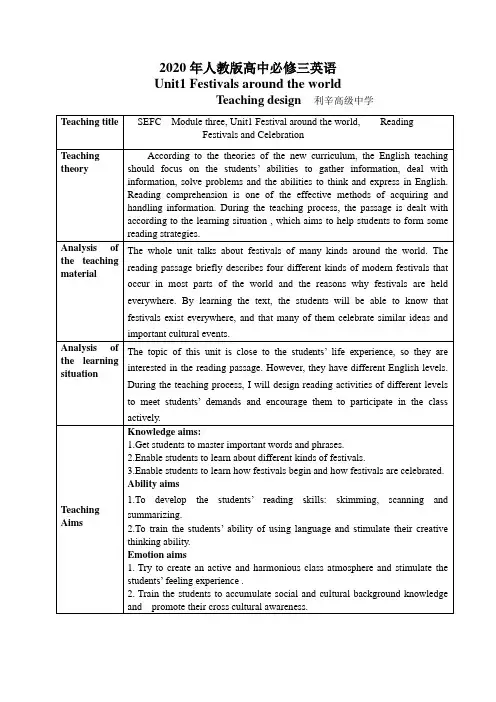
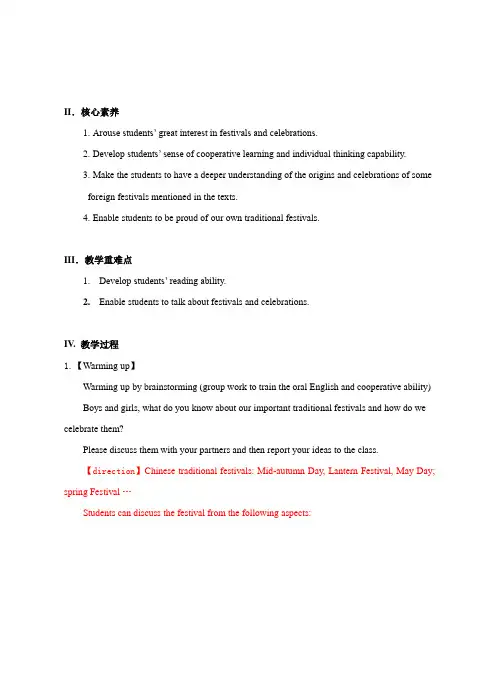
II.核心素养1.Arouse students’ great interest in festivals and celebrations.2.Develop students’ sense of cooperative learning and individual thinking capability.3.Make the students to have a deeper understanding of the origins and celebrations of someforeign festivals mentioned in the texts.4.Enable students to be proud of our own traditional festivals.III.教学重难点1.Develop students’ reading ability.2.Enable students to talk about festivals and celebrations.IV. 教学过程1.【Warming up】Warming up by brainstorming (group work to train the oral English and cooperative ability) Boys and girls, what do you know about our important traditional festivals and how do we celebrate them?Please discuss them with your partners and then report your ideas to the class.【direction】Chinese traditional festivals: Mid-autumn Day, Lantern Festival, May Day; spring Festival …Students can discuss the festival from the following aspects:【sample: 】Spring FestivalWe celebrate the end of winter, arrival of spring, Lunar New Year, reunion with family and relatives. During Spring Festival, people give money in red paper to children; see dragon dances; eat fish, prawns and dumplings; visit family member.What about the popular foreign festivals, who would like to share your ideas with your class?【Keys 】Thanksgiving Day; Valentine’s Day; Christmas Day….2.【Reading】Task I: Read for general outline:Read through the passage and find out how many types of festivals are mentioned in the passage?1. 2 . _____________________3 4 .________________________5.______________________【Keys 】1. Ancient festivals2. Festivals of the Dead3. Festivals to Honor the People4. Harvest Festivals5. Spring FestivalsT ask II: Read for detailsPara. 1 Ancient FestivalFor what people celebrate:【Keys 】Festivals are meant to celebrate the important moment of a year. What festivals are mentioned in each paragraph?Para 2. Festival _______________________Country name of the festival【Keys 】Para. 2 Festivals of the DeadJapan -----ObonMexico------Day of the DeadAmerica------HalloweenPara 3. Festival _______________________Country name of the festival【Keys 】Para. 3 Festivals to Honour PeopleChina ----- Dragon Boat FestivalUSA ----- Columbus DayIndia ----- festival to honour GandhiPara 4 Festival _______________________Country name of the festival【Keys 】European and other countries----- Harvest and Thanksgiving Festival China and Japan----- Mid-Autumn festivalPara 5 Festival _______________________Country name of the festival【Keys 】China ----- Spring festivalSome Western countries ----- Easter and related holidaysJapan ----- Cheery Blossom FestivalTask III True or false1. The ancient people needn’t worry about their food. ( )2. Halloween used to be a festival intended to honor the dead. ( )3. Qu Y uan was a great poet who people honor a lot in China. ( )4. Mid-autumn Festival is held to celebrate the end of autumn. ( )5. Easter celebrates the birth of Jesus ( )【Keys 】1.F 2T 3.T 4.F 5.FTask IV: Read it more carefully and try to answer the following questions1). What are festivals of the dead usually for?【Keys 】Festivals of the dead are for honoring or satisfying dead ancestors or others, who some people believe might return to help or harm living people.2) What makes autumn festivals happy events?【Keys 】Autumn festivals are happy events because people are thankful that food is ready for winter and the hard farm work is finished.3). What do people usually do at spring festivals?【Keys 】At spring festivals, people usually have dances, carnivals and other activities to celebrate the end of winter and the coming of spring.4). Compare the festivals of the dead in Mexico, Japan and China. What things are similar? What things are different?【Keys 】The Chinese, Japanese and Mexican festivals of the dead all have customs to honour the dead. The Chinese and Japanese go to clean their ancestors’ graves, and the Mexicans offer food, flowers and gifts to the dead.However, there are some difference. The Mexicans eat special food that looks like bones, something the Chinese and Japanese do not do.5). What are important reasons to have festivals and celebrations?【Keys 】It is important to have festivals and celebrations so we can enjoy life/ be proud of our customs/forget our work for a little while.Post-reading activityRead the text again to understand the following phrases. You can look them up in the dictionary1 be meant to do 2. take place 3. do harm 4. In memory of5 in the shape of6 dress up 7. play a trick on them 8 decorate…with9 get together 10 admire the moon 11 look forward to12 have fun with 13. be proud ofTranslate the following sentences orally.1.Most ancient festivals would celebrate the end of cold weather….2.At that time people would starve if food was difficult to find.3.Some festivals are held to honor the dead or to satisfy the ancestors…4.The country, covered with cherry tree flowers, looks as though it is covered with pinksnow.【ability promotion】Homework:1. Go over the text after class and try to write a summary of the text (about 100 words) and retell the text according to the summary.2. Try to find out as much information as possible about festivals around the world. You can surf the Internet or refer to the books.V.教学反思略。
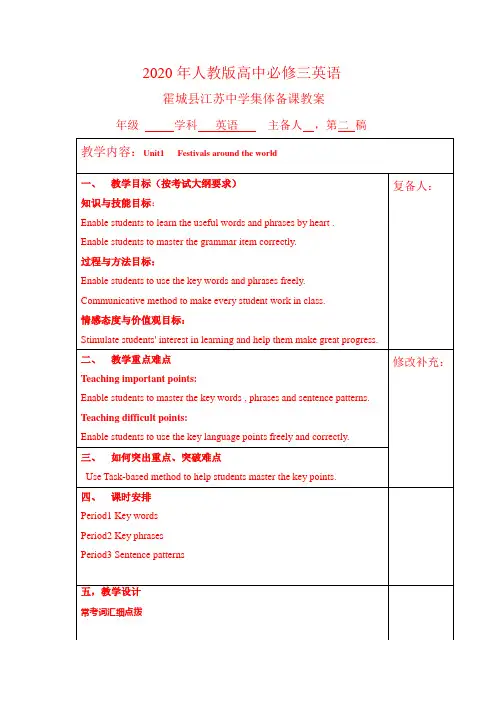
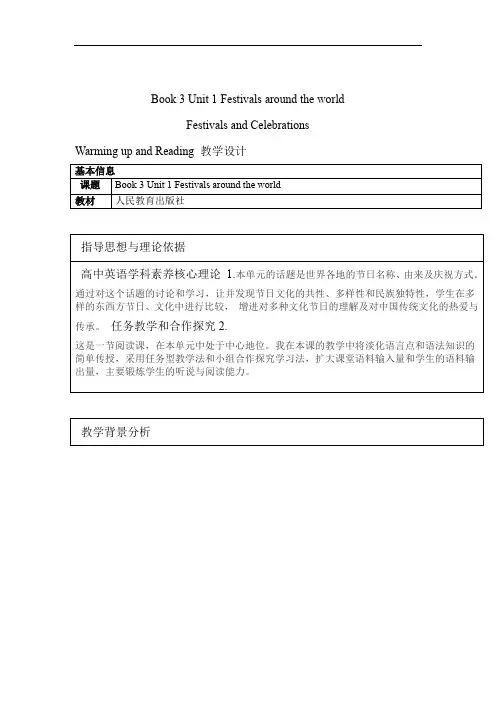
Book 3 Unit 1 Festivals around the world
Festivals and Celebrations Warming up and Reading 教学设计
体会古代节日
与现代节日的
节日名称,庆祝目的,国家,及庆祝活动
了解该节日的目的;对中国的清明节,日本的盂兰盆节及墨西哥的亡灵节进行对比,能列举节日活动;对亡灵节进行深入理解,能正确
看待死亡。
通过组织对话的形式,灵活运用语段内的有效信息,做到学以致用
学生结合实际生活,总结春节期间的活动。
还须给出其他活动,拓
识知展学生面。
排序题意在
考查学生对于细节的把握,找出关键词总结节日的意义,重在实际应用
例,知识上
部分难度较大,为得到较好效果,须给出关键词,帮助学生思考归纳)。
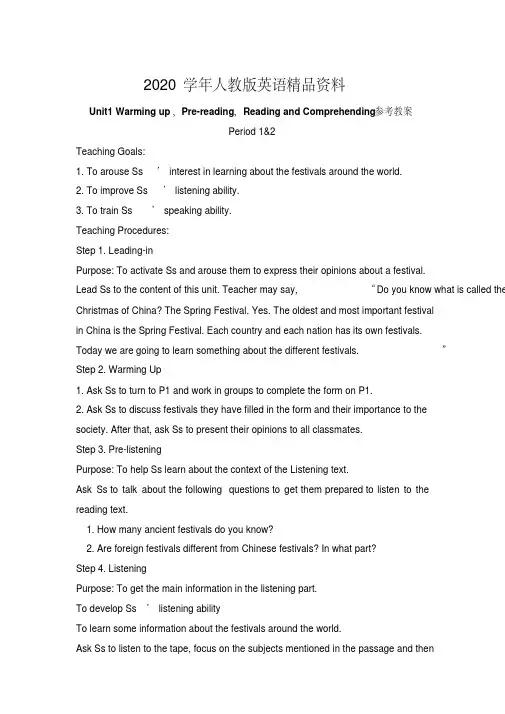
2020学年人教版英语精品资料Unit1 Warming up,Pre-reading,Reading and Comprehending参考教案Period 1&2Teaching Goals:1. To arouse Ss’ interest in learning about the festivals around the world.2. To improve Ss’ listening ability.3. To train Ss’ speaking ability.Teaching Procedures:Step 1. Leading-inPurpose: To activate Ss and arouse them to express their opinions about a festival.Lead Ss to the content of this unit. Teacher may say, “Do you know what is called the Christmas of China? The Spring Festival. Yes. The oldest and most important festivalin China is the Spring Festival. Each country and each nation has its own festivals.Today we are going to learn something about the different festivals.”Step 2. Warming Up1. Ask Ss to turn to P1 and work in groups to complete the form on P1.2. Ask Ss to discuss festivals they have filled in the form and their importance to thesociety. After that, ask Ss to present their opinions to all classmates.Step 3. Pre-listeningPurpose: To help Ss learn about the context of the Listening text.Ask Ss to talk about the following questions to get them prepared to listen to thereading text.1. How many ancient festivals do you know?2. Are foreign festivals different from Chinese festivals? In what part?Step 4. ListeningPurpose: To get the main information in the listening part.To develop Ss’ listening abilityTo learn some information about the festivals around the world.Ask Ss to listen to the tape, focus on the subjects mentioned in the passage and thenanswer the following question.How many kinds of festivals were mentioned in the text?Suggested Answer: Five.What are they?Suggested Answer:Ancient FestivalsFestivals of the DeadFestivals to Honor PeopleHarvest FestivalsSpring FestivalsStep 5. Pre- readingDivide Ss into groups of four and ask them to discuss the following questions.1. What’s your favorite holiday of the year? Why?2. What festivals or celebrations do you enjoy in your city or town? Do you like spending festivals with your family or with friends? What part of a festival do you like best---the music, the things to see, the visits or the food?Step 6. Fast readingAsk Ss to read the text quickly and answer the following questions.1. What are festivals of the dead usually for?2. What make autumn festivals happy events?3. What do people usually do at spring festivals?4. What is one important reason to have festivals and celebrations?5. Compare the festivals of the dead in Mexico, Japan and China. What things are similar? What things are different?Suggested Answers:1. Festivals of the dead are for honoring or satisfying dead ancestors or others, who some people believe might return to help or harm living people.2. Autumn festivals are happy events because people are thankful that food is ready for winter and the hard farm work is finished.3. At spring festivals, people usually have dances, carnivals and other activities tocelebrate the end of winter and the coming of spring.4. It is important to have festivals and celebrations so we can enjoy life / be proud ofour customs / forget our work for a little while.5. The Chinese, Japanese a nd Mexican festivals of the dead all have customs tohonour the dead. The Chinese and Japanese go to clean their ancestors’ graves, an the Mexican offer food, flowers and gifts to the dead. However, there are somedifferences. The Mexicans eat special food that looks like bones, something theChinese and Japanese do not do.Step 7. Intensive reading1. Ask Ss to read the text carefully and sum up the main idea of each part.2. Discuss in pairs which festivals you think are the most important and which arethe most fun. Then fill in the chart with your ideas.Type of festival Example of festival Reasons for your choiceMostimportantMost funSuggested Answer:Various answers are acceptable.3. Ask Ss the following question and encourage Ss to give some similarities that theythink festivals have, and give their reasons. Then invites Ss to tell the similarities andthen ask them to present them before the class.What similarities can you find among these festivals?Suggested Answer:They most include food, music or entertainment, like dances, light or fire.They are most together with family and friends.Festivals exist everywhere.Many of them celebrate similar ideas and important cultural events or remember eventof people.Human beings need to have things in life to celebrate and have a break from daily struggles and demands.Step 8. HomeworkPurpose: To get a further understanding of the text.1. Ask Ss to continue discussing their opinions about festivals with their partners.2. Ask Ss to read the text once again and try to retell the text.3. Ask Ss to discover useful words and expressions in the text.。
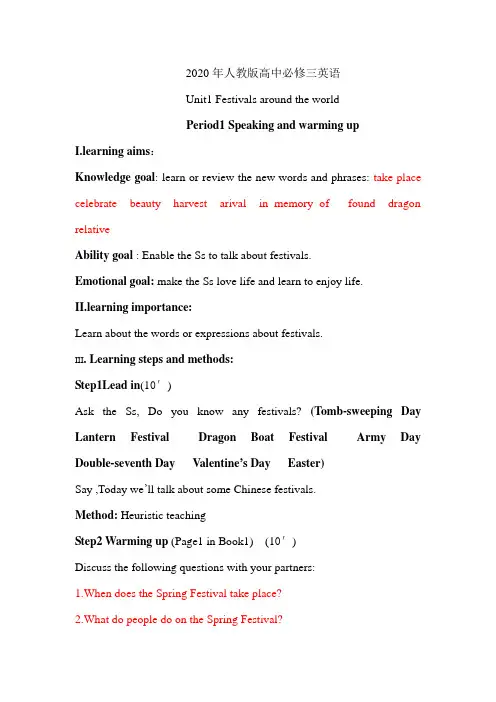
2020年人教版高中必修三英语Unit1 Festivals around the worldPeriod1 Speaking and warming upI.learning aims:Knowledge goal: learn or review the new words and phrases: take place celebrate beauty harvest arival in memory of found dragon relativeAbility goal : Enable the Ss to talk about festivals.Emotional goal: make the Ss love life and learn to enjoy life.II.learning importance:Learn about the words or expressions about festivals.III. Learning steps and methods:Step1Lead in(10′)Ask the Ss, Do you know any festivals? (Tomb-sweeping Day Lantern Festival Dragon Boat Festival Army Day Double-seventh Day Valentine’s Day Easter)Say ,Today we’ll talk about some Chinese festivals.Method: Heuristic teachingStep2 Warming up (Page1 in Book1) (10′)Discuss the following questions with your partners:1.When does the Spring Festival take place?2.What do people do on the Spring Festival?3.What does it celebrate?Have the Ss talk about the three festivals, the Spring Festival Dragon Boat Festival National Day. Then try to finish the chart. Methods: disscuss in groups and presentStep3 Sum up the important vocabulary. (10′)festival celebrate take place beauty harvest arivalin memory of found dragon relativeStep4 Homework1.Remember the keywords and phrases.2.Preview the reading passage:Festivals and celebrations教后记:1.备课除了备好教材,更应充分备好教学对象、即学生。
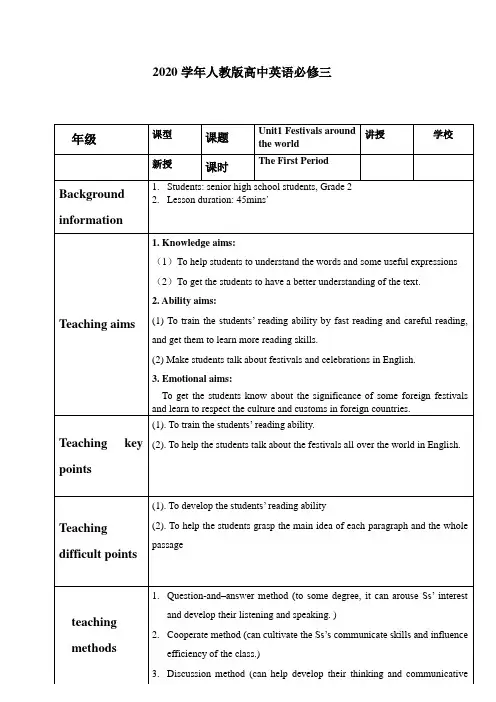
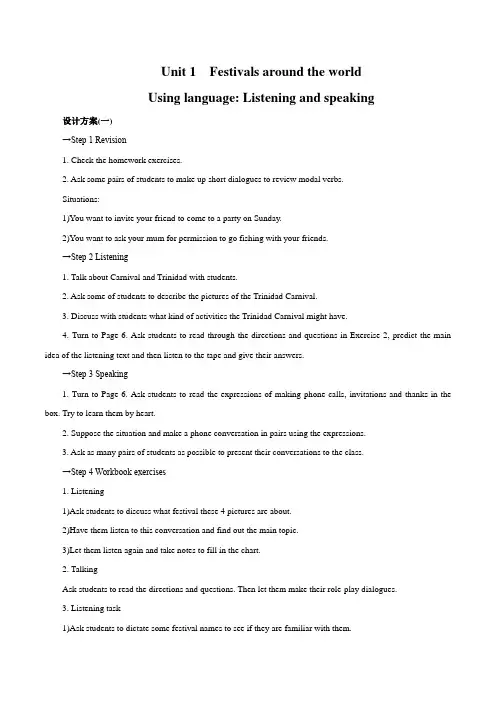
Unit 1Festivals around the worldUsing language: Listening and speaking 设计方案(一)→Step 1 Revision1. Check the homework exercises.2. Ask some pairs of students to make up short dialogues to review modal verbs.Situations:1)You want to invite your friend to come to a party on Sunday.2)You want to ask your mum for permission to go fishing with your friends.→Step 2 Listening1. Talk about Carnival and Trinidad with students.2. Ask some of students to describe the pictures of the Trinidad Carnival.3. Discuss with students what kind of activities the Trinidad Carnival might have.4. Turn to Page 6. Ask students to read through the directions and questions in Exercise 2, predict the main idea of the listening text and then listen to the tape and give their answers.→Step 3 Speaking1. Turn to Page 6. Ask students to read the expressions of making phone calls, invitations and thanks in the box. Try to learn them by heart.2. Suppose the situation and make a phone conversation in pairs using the expressions.3. Ask as many pairs of students as possible to present their conversations to the class.→Step 4 Workbook exercises1. Listening1)Ask students to discuss what festival these 4 pictures are about.2)Have them listen to this conversation and find out the main topic.3)Let them listen again and take notes to fill in the chart.2. TalkingAsk students to read the directions and questions. Then let them make their role-play dialogues.3. Listening task1)Ask students to dictate some festival names to see if they are familiar with them.2)Let them listen to the tape and write the festival for each picture on Page 45.3)Have them go through the questions and then listen again to find the answers. →Step 5 Homework1. Finish off the related Workbook exercises.2. Make up a phone conversation using the expressions of invitations and thanks.板书设计Unit 1Festivals around the worldListening and speakingMAKING PHONE CALLS May I speak to. . . ?Can I ring/call back later? Hold/Hang on, please.I’ll ring him/her up again.Just a moment, please. Sorry, he/she isn’t here right now.INVITATIONSI wonder if you are interestedin. . . .I’d like to invite you to. . . .Would you like. . . ?Could/Would you please. . . ?I’m looking forward to. . . .I’d love to, but. . .THANKSThank you so much.Thanks a lot.That’s very kind of you.You’re most welcome.Don’t mention it.It’s a pleasure.活动与探究Imagine you want to invite a foreign friend to join your family’s celebration of the Chinese Spring Festival. In pairs, one as the Chinese student and the other as the foreign friend, make up a phone conversation to give your invitation, ask and answer questions about the holiday. The foreign friend should express his or her thanks for your invitation. Be ready to act out your conversation to the class.设计方案(二)教材分析This is the fourth teaching period of this unit. As usual, the teacher will first get students to review what they learned in the last period, and then lead in the new lesson.We will mainly deal with listening and speaking in this period. At the beginning, students listen to a conversation among young people. Carla and Hari are students in Trinidad. Their Chinese friends Li Mei and Wu Ping, are visiting for the Carnival holiday in February. They are joining in a parade for Carnival in Trinidad. This listening activity is not only to offer students knowledge about how to celebrate Carnival in Trinidad but toencourage students to listen and then use what they have heard to help them answer questions. It is an important exercise because it links skills together and uses them to produce a useful phone call. Make sure students read the questions before they listen to the tape. This is to sharpen their attention and listen for the answers. This will also help them get the gist of the listening text. The teaching procedures may be as follows: First, let students go through the directions, pictures and the questions and guess the listening text may be about. Play the tape for students to listen to and decide whether their guessing is right. Second, ask them to listen again for them to answer the questions. Third, let them listen a third time to check their answers. While they are listening, the teacher should pause and repeat the key sentences to help students understand. When checking the answers, explain some difficult listening points if necessary. In the end, show them the listening text and let them read and retell it. This step can help students understand and grasp the listening material far further. Perhaps some students will find it hard to listen to and understand listening materials. Encourage them not to give up. The more they listen to English, the easier it becomes.The speaking exercise is intended to give students the opportunity to practice a phone conversation using the functional items. So they should learn some expressions on how to make phone calls and invitations and express and thanks first. Then they are required to create such a phone conversation. During the course, let them know the polite forms of English are important and should be practiced in a variety of situations. Also encourage them to use vocabulary from the reading and listening passages.This period places emphasis on developing students’ listening and speaking ability. We should try our best to encourage students to say something. Don’t always correct the mistakes they have made while they are speaking. Otherwise, they would feel reluctant and not say anything more.教学重点1. Develop students’ listening and speaking abilities.2. Enable students to master different listening skills.3. Let students learn how to make phone calls and invitations and express thanks.教学难点1. Get students to listen to and understand listening materials with various English accents.2. Let students make a phone conversation using the functional items requests and thanks.三维目标知识目标1. Get students to learn some useful new words and expressions in the listening passage.2. Let students learn the following expressions:1)Making phone callsMay I speak to. . . ?Can I ring/call back later?Hold/Hang on, please.I’ll ring him/her up again.Just a moment, please.Sorry, he/she isn’t here right now.2)InvitationsI wonder if you are interested in. . .I’d like to invite you to. . .Would you like. . . ?Could/Would you please. . . ?I’m looking forward to. . .I’d love to, but. . .3)ThanksThank you so much.Thanks a lot.That’s very kind of you.You’re most welcome.Don’t mention it.It’s a pleasure.能力目标1. Enable students to catch and understand the listening materials.2. Develop students’ ability to get special information and take notes while listening.3. Get students to learn and use the expressions of making phone calls, invitations and thanks. 情感目标1. Enable students to know more about festivals and love their life.2. Develop students’ sense of group cooperation and teamwork.教学过程设计方案(一)→Step 1 Revision1. Check the homework exercises.2. Ask some students to translate some sentences using modal verbs.1)我们中有些人现在会用电脑, 但我们10年前不会用。
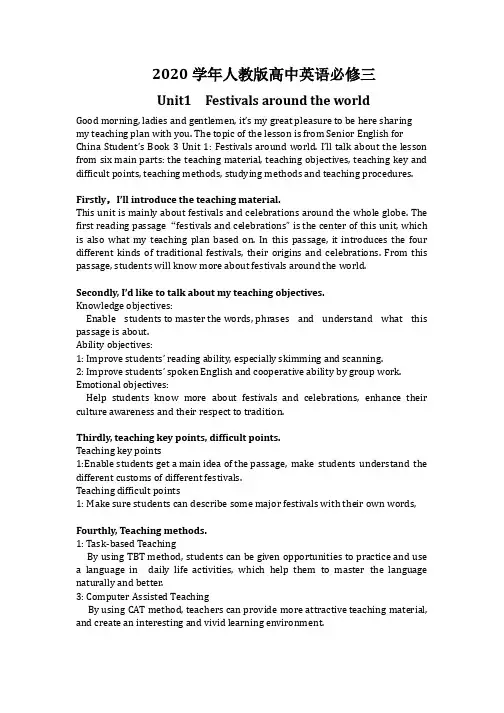
2020学年人教版高中英语必修三Unit1 Festivals around the worldGood morning, ladies and gentlemen, it’s my great pleasure to be here sharing my teaching plan with you. The topic of the lesson is from Senior English for China Student’s Book 3 Unit 1: Festivals around world. I’ll talk about the lesson from six main parts: the teaching material, teaching objectives, teaching key and difficult points, teaching methods, studying methods and teaching procedures. Firstly,I’ll introduce the teaching material.This unit is mainly about festivals and celebrations around the whole globe. The first reading passage“festivals and celebrations” is the center of this unit, which is also what my teaching plan based on. In this passage, it introduces the four different kinds of traditional festivals, their origins and celebrations. From this passage, students will know more about festivals around the world. Secondly, I’d like to talk about my teaching objectives.Knowledge objectives:Enable students to master the words, phrases and understand what this passage is about.Ability objectives:1: Improve students’ reading ability, especially skimming and scanning.2: Improve students’ spoken English and cooperative ability by group work. Emotional objectives:Help students know more about festivals and celebrations, enhance their culture awareness and their respect to tradition.Thirdly, teaching key points, difficult points.Teaching key points1:Enable students get a main idea of the passage, make students understand the different customs of different festivals.Teaching difficult points1: Make sure students can describe some major festivals with their own words, Fourthly, Teaching methods.1: Task-based TeachingBy using TBT method, students can be given opportunities to practice and use a language in daily life activities, which help them to master the language naturally and better.3: Computer Assisted TeachingBy using CAT method, teachers can provide more attractive teaching material, and create an interesting and vivid learning environment.Fifthly, studying methods.1: Task-based learning.2: Cooperative learningSixthly, Teaching procedures.1: Lead-inShow students a short video some traditional festivals’ celebrations. After watching that, ask students questions like “have you ever had these festivals?” “what do you do at these festivals?” “how do you know about these festivals?”Justification: in the beginning of the class, I want to use online video to create a lively environment in which students can get involved in more quickly, and also activate students interest and background knowledge of the topic.2: While-reading.Task 1 SkimmingDivide students into 8 groups, give them 3 minutes to glance over the title and each paragraph, then try to discuss and sum up the main idea of each and the theme of the whole passage.Justification: practice students’ ability of reading for the general idea, moreover, by group disc ussion, turn passive study to active study, and enhance students’ spoken English and the consciousness of cooperative learning.Task 2 ScanningGive students 8 minutes to read the passage carefully, then ask them questions like:1, what festivals are held to honour the dead and ancestors?2, who is honoured in India in October 2?3, what do European people do to celebrate harvest?4, what festivals are celebrated in Spring?Justification: practice students’ ability of reading for specific information. And also, by answering those questions students can have a better understanding of festivals around the world.3: Post-reading.Divide students into 8 groups, ask students to find out and discuss all the festivals and celebrations mentioned in the passage. After that, each group sends a representative to describe two festivals in front of the whole class. Justification: deepen students’ knowledge of today’s class. Make sure students can talk about festivals and celebrations by using their own words. Encourage students to express themselves in the face of people and to cooperate with others.4: Consolidation.Ask students to review the passage very quickly then complete the exercise below.Justification: review and consolidate the knowledge we’ve just learnt.5: Homework.Write an essay to introduce a festival and how it is celebrated.Justification: this activity does not only strengthen students’ understanding of different kinds of festivals and celebrations, but also improve students’ interculture awareness.。
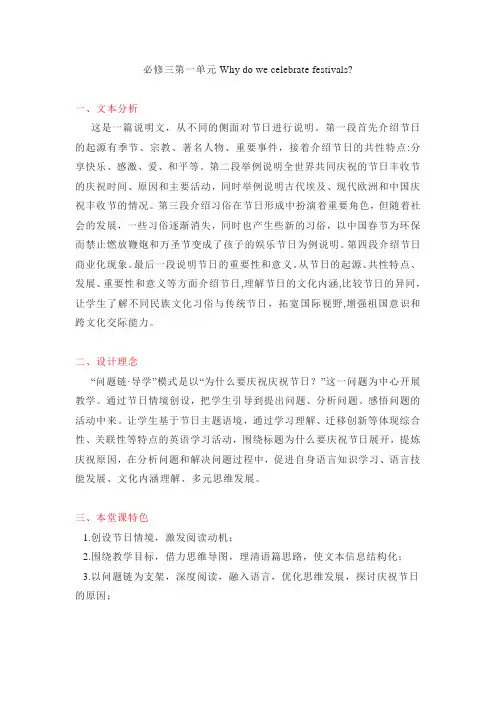
必修三第一单元Why do we celebrate festivals?一、文本分析这是一篇说明文,从不同的侧面对节日进行说明。
第一段首先介绍节日的起源有季节、宗教、著名人物、重要事件,接着介绍节日的共性特点:分享快乐、感激、爱、和平等。
第二段举例说明全世界共同庆祝的节日丰收节的庆祝时间、原因和主要活动,同时举例说明古代埃及、现代欧洲和中国庆祝丰收节的情况。
第三段介绍习俗在节日形成中扮演着重要角色,但随着社会的发展,一些习俗逐渐消失,同时也产生些新的习俗,以中国春节为环保而禁止燃放鞭炮和万圣节变成了孩子的娱乐节日为例说明。
第四段介绍节日商业化现象。
最后一段说明节日的重要性和意义。
从节日的起源、共性特点、发展、重要性和意义等方面介绍节日,理解节日的文化内涵,比较节日的异同,让学生了解不同民族文化习俗与传统节日,拓宽国际视野,增强祖国意识和跨文化交际能力。
二、设计理念“问题链·导学”模式是以“为什么要庆祝庆祝节日?”这一问题为中心开展教学。
通过节日情境创设,把学生引导到提出问题、分析问题、感悟问题的活动中来。
让学生基于节日主题语境,通过学习理解、迁移创新等体现综合性、关联性等特点的英语学习活动,围绕标题为什么要庆祝节日展开,提炼庆祝原因,在分析问题和解决问题过程中,促进自身语言知识学习、语言技能发展、文化内涵理解、多元思维发展。
三、本堂课特色1.创设节日情境,激发阅读动机;2.围绕教学目标,借力思维导图,理清语篇思路,使文本信息结构化;3.以问题链为支架,深度阅读,融入语言,优化思维发展,探讨庆祝节日的原因;4.回归标题,针对“festival”首字母,回归课文,再次提炼庆祝节日的意义,升华主题。
四、教学目标1.获取段落大意,梳理节日的起源、共性特点、发展等信息;2.描述中外节日异同,理解不同节日的重要性;3.分析和总结庆祝节日的原因;4.写一篇介绍清明节的应用文。
五、教学步骤Step1:学习理解类活动1. 围绕主题创设情境,铺垫语言以临近的清明节为导入,Why do we celebrate Tomb Sweeping Day? How do we celebrate it?Step2:概括、梳理、整合信息1. 寻找段落大意总结阅读技巧。
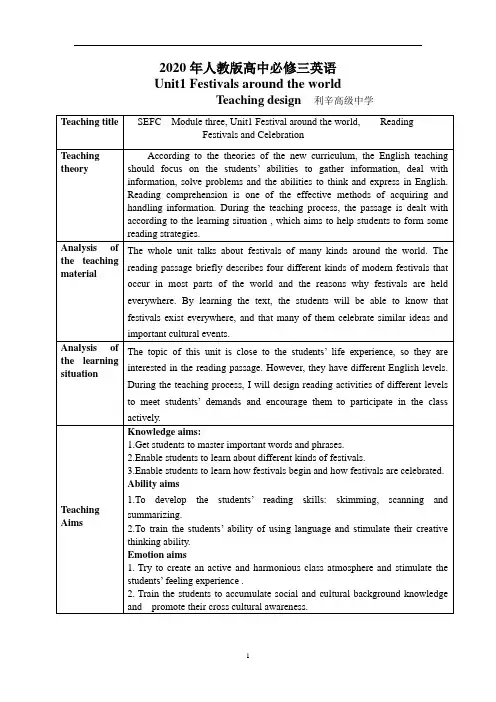
2020年人教版高中必修三英语Unit 1 Festivals around the worldGrammarI.Teaching contents: The model verb (1)II.Teaching aims:1.To get Ss to have knowledge of the grammar point: the model verb2.To develop the ability to use thethe model verbIII.Key points & DifficultiesKey points:Get Ss to learn and master the use of modal verbs.Teaching DifficultiesEnable Ss to learn how to use some verbs correctly.IV.Teaching methodsDiscussing, summarizing and practicing.V.Teaching procedure:Step 1: Lead-inAsk Ss to speak some sentences which are containing modal verbs, then analyze the modal verbs used in the sentence.Step 2: Grammar explanationcan 和couldl)can的主要用法是:A.表示体力或脑力的能力: e.g. The girl can dance very well.B.表示说话的推测、事物的可能性等:e.g. Can the news be true?C.在口语中,can可以表示请求或允许:e.g. Can I sit here?can表示"能够”时与短语be able to同义,但can只用于一般现在时或过去时,而后者可用于各种时态。
2020学年人教版高中英语必修三Unit 1山东省青州第一中学一.教学课型:阅读课二.教材分析:1.教学内容(教材内容见文末)2.教材处理本节课主要介绍了古今中外的节日的种类,节日的由来,节日的作用及其庆祝方式等。
学生们虽然在日常生活中对此有所接触,但了解并不是很透彻,很全面,尤其是对国外的节日。
在本节课的教学设计中,笔者从大量的图片、音乐动画、录像着手,使学生在已经积累的感性材料的基础上,随着阅读的层层推进,不仅增进了对中国节日的理解,而且对外国一些节日也有所了解和感悟。
提高了学生的文化素质,进而增强了跨国文化交际意识,并利用多媒体技术创设各种情境,为学生提供了众多参与的机会,这样既保证了信息的大量输入,又实现了足够的输出,而只有通过输出才能使学生真正掌握所学内容,真正成为课堂的主人,充分调动了学生自主学习的积极性。
3 .教学目标1 .知识目标:通过深层次的理解,使学生了解古今中外的节日,并完成有关课文内容的练习。
2 .能力目标:通过个人活动,同伴活动和小组活动,使学生掌握速读—略读—跳读—精读—总结—寻找细节等阅读文章的各种阅读技巧,并利用多媒体课件创设情境,为学生提供大量的输出机会,提高学生的听说读写能力及培养他们的发散思维与创新能力。
3 .情感目标:体验使用多媒体手段辅助学习的乐趣和成就感,激发学生对世界各地,尤其是中国的节日及文化的兴趣,提高他们的文化素质,进而增强跨国文化意识。
4、教学重点与难点(1)培养学生的阅读策略及获取信息的方法。
(2)创设情境,激活学生思维,培养学生的合作学习能力以及发现问题,思考问题和解决问题的能力。
三、教学媒体选择多媒体教室、计算机、CAI课件、投影仪四、教学设计1.总体思路笔者将本节课的主要内容分为四大环节:Pre-reading activities for interest(读前活动),while-reading activities for comprehension (读中活动), post-reading for consolidation (读后巩固活动) , group work and writing(小组活动与短文写作)。
2020学年人教版高中英语必修三Unit 1 Festivals around the world一、说教材(一)说教材的地位和作用本课是人民教育出版社高二英语必修3第一单元第一课时的内容。
本单元的中心话题是“Festivals Around the World”,主要介绍了世界各地一些传统节日内容,历史由来以及节日的庆祝方式。
本课是本单元的第一课时,主要讲述some festivals about the dead,harvest, spring and to honor people。
它为第二课时festival origin“a sad love story”的学习作铺垫。
本课时的学习不但能使学生学习掌握新单词和短语,以及moral verb用法,还能帮助学生熟悉各国不同的节日,开拓视野,激发学生深入了解各国节日传统的兴趣,引导积极主动探索更多的相关知识。
(二)教学目标:根据《课程标准》,本单元要求依据高二年级学生特点确定以下目标:1、知识与技能(1)学生能理解和掌握新单词短语,如:take place, hunters, religious, ancestors, in memory of, day and night等;(2)学生能掌握情态动词的用法,正确区分can-could\may-might\shall-should\will-would及其之间的区别。
(3)提高学生的阅读能力以及语言表达能力2、过程与方法(1)通过引导学生根据文章猜测生词含义及呈现相关例句来使学生掌握新单词与短语;(2)通过列表对比讲解及呈现巩固练习来使学生正确区分四组情态动词的用法;(3)通过阅读训练提高学生的阅读能力和抓取有效信息的能力3、情感、态度与价值观提高学生对于英语学习的兴趣并获得对于世界各国节日文化传统更多的知识信息,有利于培养跨文化交际意识。
(三)教学重点难点及确定依据根据课程标准,本课时的重点、难点如下:重点:1、学生能理解和掌握新单词短语,如:take place, hunters, religious, ancestors, in memory of, day and night等;2、提高学生的阅读能力以及语言表达能力难点:学生能掌握情态动词的用法,正确区分can-could,may-might,shall-should,will-would 及其之间的区别。
2020学年人教版高中英语必修三English Teaching PlanTeaching lesson:Unit 1 Festivals around the worldTeaching target:First year students in the senior high schoolClass type:ReadingTime:45 minutesI. Teaching objectivesA. Know the purposes, customs and activities of the festivals in thetext book;B. Understand the brief background and the culture information ofdifferent countries mentioned;C. Know some other common festivals in different countries;II. The analysis of the teaching backgroundA. The analysis of the studentsAfter at lease 3-year learning of English, the first year students inthe senior high school have mastered basic grammar knowledgeand learned the brief culture of the English countries. They canread some text individually and want to know more about theculture because of their curiosity.B. The analysis of the teaching materialsThe lesson Festivals around the world is the main text inunite of the third book in senior high school. It introducesdifferent festivals in the world, including their names, times,countries, purposes, customs and activities of them.The teacher can use the PPT, pictures, videos, Internet and other sources during the classC. The analysis of the learning environment (according to thepractical situation of them)III. The teaching tasksA. Make the students familiar with the names, purposes, customs andactivities of the festivals in different countries in the text;B. Guide the students learn the brief background and the culture ofdifferent festivals mentioned in the text;IV. Teaching contentsA. The names, countries, purposes, customs and activities of differentfestivals mentioned, including:1. Festivals of the Dead2. Festivals to the Honor People3. Harvest Festivals4. Spring FestivalsB. The background and the culture of different festivals mentionedin the text;C. The other main festivals of the foreign countries;V. The important pointsA. The names and the countries of different festivals;B. The purposes, customs and activities of the festivals.VI. The difficult pointsA. The purposes, customs and activities of the festivalsB. The background and the culture of different festivals;VII. Teaching aidsBlackboard, chalk, PPT, pictures, white papers,VIII. Choices and development of the sourceChoose the available facilities and source through the Internet and the library, such as graphs, videos, pictures and description.IX. Teaching methodsA. TBLT (task-based language teaching);B. CLT (communicative Language Teaching);X. ProceduresStep1. Pre-reading activities (10 minutes)A. The teacher shows some pictures of the different festivals by PPTand the students guess the names of them.1. The teacher shows the pictures of the Qing Ming Festival andthe Dragon Boat Festival by PPT and asks the students whatthey are doing in the pictures;2. Show the pictures of the Moon cakes and the Zongzi (粽子)byPPT and ask the students when do they eat them;3. The teacher shows the pictures of the famous people by PPTand asks the students who are they;4. Pair worksa. Make the students ask their partners the followingquestions and the other answers them.i. What is your favorite Chinese festival?ii. Do you know some foreign festivals and name them.b: the teacher asks 2 pairs to show their work.Step2. While- reading (20minutes)A. the students scan the test book, find the festivals and underlinethem;B. The teacher asks the student to speak out the names of the festivalsthey have found and then the teacher completes the students’ answers, writing them on the blackboard;C. The teacher teaches the students to read the festivals on theblackboard;D. The teacher shows the festivals mentioned in the text by PPT andintroduce some background of the festivals and people to them;1. Festivals of the Deada. Obon (Japan)b. Halloween (Western countries)c. Day of the Dead (Mexico)2. Festivals to the Honor Peoplea. Columbus Day (USA)b. Indian National Day on October 2 (India)c. The Dragon Boat Festival (China)3. Harvest Festivalsa. Thanksgiving Festivalb. Mid-autumn Festival4. Spring Festivalsa. The Chinese Spring Festival (show a video about it)b. Easterc. Cherry Blossom FestivalE. the teacher makes the students read the text carefully and find thepurposes, customs and activities of different festivals;Step3. Post-reading (15minutes)A. The students answer the questions above and the teacher shows them in PPT step by step;B. the teacher leads the students to summary the reading;1. Festivals of the Dead1).Obon (Japan) ------to honor the dead or to satisfy the ancestors------clean graves, light incense (香),light lamps, play music.2). Day of the Dead (Mexico) ------ eat food in the shape of skulls and cakes with "bones" on them, offer food, flowers and gifts to the dead (early November);3).Halloween (Western) ------ beliefs about the return of the spirits of dead people------ dresses up and go to their neighbors’ homes to ask for sweets, play some tricks;2. Festivals to Honor People1)The Dragon Boat Festival (China) ------ honor the famous poet, Qu Yuan(屈原).2)Columbus Day (USA) ------ in memory of the arrival of Christopher Columbus in the New World.3)National festival on October 2 (India) ------ to honor Mohandas Gandhi3. Harvest Festivals1)Thanksgiving festivals (America and Canada) ------ food is gathered for the winter and the agricultural work is over------ decorate churches and town halls with flowers and fruit, get together to have meals, Some people might win awards for their farm produce;2)Mid-autumn festivals (China, Japan) ------ admire the moon------ appreciate the moon; Enjoy the moon cakes and wine;4. Spring Festivals1)The Spring Festival(China)------look forward to the end of winter and to the coming of spring------ eat dumplings, fish and meat and may give children lucky money in red paper. There are dragon dances and carnivals, and families celebrate the Lunar New Year together;2)Easter (western countries) ------ celebrates the return of Jesus from the dead and the coming of spring and new life;3)Cherry Blossom Festival (Japan) ------appreciate cherry tree flowersC. The teacher asks the students if they have any other questions and thenanswers the questions advocated by the students;D. Homework for the students;1. Talk with your friends:Which festivals do you like best, why?2. Search more information about the festivals mentioned in the text. XI. ReflectionTo be written immediately after the lesson附:课文:普通高中课程标准实验教科书英语必修3 Unit 1Festivals around the worldFestivals and celebrations of all kinds have been held everywhere since ancient times. Most ancient festivals would celebrate the end of cold weather, planting in spring and harvest in autumn. Sometimes celebrations would be held after hunters had caught animals. At that time people would starve if food was difficult to find, especially during the cold winter months. Today's festivals have many origins, some religious, some seasonal, and some for special people or events.Festivals of the DeadSome festivals are held to honor the dead or to satisfy the ancestors, who might return either to help or to do harm. For the Japanese festivalObon, people should go to clean graves and light incense in memory of their ancestors. They also light lamps and play music because they think that this will lead the ancestors back to earth. In Mexico, people celebrate the Day of the Dead in early November. On this important feast day, people eat food in the shape of skulls and cakes with "bones" on them. They offer food, flowers and gifts to the dead. The Western holiday Halloween also had its origin in old beliefs about the return of the spirits of dead people. It is now a children's festival, when they can dress up and go to their neighbors' homes to ask for sweets. If the neighbors do not give any sweets, the children might play a trick on them.Festivals to Honor PeopleFestivals can also be held to honor famous people. The Dragon Boat Festival in China honors the famous ancient poet, Qu Yuan. In the USA, Columbus Day is in memory of the arrival of Christopher Columbus in the New World. India has a national festival on October 2 to honor Mohandas Gandhi, the leader who helped gain India's independence from Britain.Harvest FestivalsHarvest and Thanksgiving festivals can be very happy events. People are grateful because their food is gathered for the winter and the agricultural work is over. In European countries, people will usuallydecorate churches and town halls with flowers and fruit, and will get together to have meals. Some people might win awards for their farm produce, like the biggest watermelon or the most handsome rooster. China and Japan have mid-autumn festivals, when people admire the moon and in China, enjoy moon cakes.Spring FestivalsThe most energetic and important festivals are the ones that look forward to the end of winter and to the coming of spring. At the Spring Festival in China, people eat dumplings, fish and meat and may give children lucky money in red paper. There are dragon dances and carnivals, and families celebrate the Lunar New Year together. Some Western countries have very exciting carnivals, which take place forty days before Easter, usually in February. These carnivals might include parades, dancing in the streets day and night, loud music and colorful clothing of all kinds. Easter is an important religious and social festival for Christians around the world. It celebrates the return of Jesus from the dead and the coming of spring and new life. Japan's Cherry Blossom Festival happens a little later. The country, covered with cherry tree flowers, looks as though it is covered with pink snow.People love to get together to eat, drink and have fun with each other. Festivals let us enjoy life, be proud of our customs and forget our work for a little while.Wangguo Festival。
2020年人教版高中必修三英语Unit 1 Festivals around the world Festivals and celebrationsGood morning, professors, it’s my great pleasure to be here sharing my lessons with you. The content of the lesson is New Senior English for China Student’s Book 3 Unit 1 festivals around the world . I’ll begin the lesson from the following 5parts,Part 1.My understanding of the lessonPart 2.Analysis of the studentsPart 3.The teaching methods ,the studying methods and teaching aidsPart 4.The teaching procedurePart 5.Blackboard designPart 1.My understanding of the lessonThe part includes teaching material , teaching aims , teaching key points and teaching difficult points.Teaching matetialThis unit is about different kinds of festivals around the world, and the reading passage plays an important part in this unit . It not only provides the chance for the students to learn about the culture and festivals in other countries,but also includes many useful words ,expressions and grammar points that students should learn in this unit. Teaching aims1. Knowledge aims:(1)To help students to understand the words and some useful expressions(2)To get the students to have a better understanding of the text2. Ability aims:(1) To train the students’reading ability by fast reading and careful reading ,and get them to learn more reading skills.3. Emotional aims:(1) To get the students to know about some foreign festivals and learn to respect the culture and customs in foreign countries.Teaching key points1. To train the students’ reading ability2. To help the students talk about the festivals all over the world in English.Teaching difficult points1. To develop the students’ reading ability2. To help the students grasp the main idea of each paragraph and the whole passage Part 2.Analysis of the studentsOn the one hand ,they’ve learnt English for years, the students have got the basic abilities of listening, speaking, reading, and writing, they still need many opportunities to practice what they have learned, to express their ideas, feelings, and experience and to develop their self-dependent learning ability and cooperative learning abilityPart 3.The teaching methods ,the studying methods and teaching aidsWhen I deal with this lesson, I’ll do my best to carry out the methods, such as self-dependent learning method,cooperative learning method,task-based teaching and learning and so on tp make t he students the real masters in class while I, the teacheracts as directorAnd I will adopt fast reading to get a general idea of the text and careful reading to get the detailed information; pair or group work to get every student to be active in class; question-and-answer activity teaching method and free discussion method to make the students smooth away the difficulties, and retelling to sum up the whole period.And I will also make good use of the modern equipment,sch as the multimedie .Part 4.The teaching procedureStep 1 Lead-inFirstly ,I will lead in the lesson of the unit with a piece of music ----jinglebell, followed by questions :1.Are you familiar with the music ?2.When can we often hear it ?Then I’ll show some beautiful pictures of the festivals all over the world in the screen, meanwhile,lead the students to talk about them.Purpose: To increase the students’ interest and attract their attention and lean in step 2. Step 2 Fast readingIn this step, the students have to finish two tasks ,Task 1 General ideaThe students will be asked to just look at the title and the pictures of the passage, and then guess what the text.is about .Purpose :to develop the students’ reading skills by making prediction and to encourage the students to express their thoughts in EnglishTask 2 Answer the question and then sort the festivalsQuestion :What festivals are mentioned in the passage?Methods: self-dependent learning method , Question-and-answer Method, task-based language teachingPurpose :To train the students’self-dependent learning ability and have a brief understanding of the passage.Step 3. Careful ReadingRead the passage carefully, and then finish Exercise 2 and Exercise 3 on page 3. Methods :cooperative learning method , task-based language teachingPurpose :To train the students to grasp the detailed information and have a better understanding of the text. It can also help the students improve the cooperative learning ability.Step 4 Discussion1.Finish Exercise 42.Now foreign festivals seem to become more and more popular among youngpeople ,while some Chinese traditional festivals seem less popular than before.Questions:1.Should we keep our traditional festivals alive ?why?How?2.Should we celebrate foreign festivals ?Methods: cooperative learning method , task-based language teachingPurpose :to train their thinking ,speaking and communication abilities and get the students to have a better understanding of the meaning of the festivals so that they can treat the festival celebrations properly.Step 5 .Summary and homework1. Get the students to retell the story with the help of the information on the blackboard.2.Creat a new festival and write a composition about it .Purpose :To review what the students have learnt ,develop their self-dependent learning ability and creative thinking ability.Part 5.Blackboard designFestivals and celebrationsWhat’s the passage about ?What festivals are metioned in the passage?Sort them.1.Festivals of the Dead2.Festivals to Honour People3.Harvest Festivals4.Spring FestivalsDiscussionQuestions:3.Should we keep our traditional festivals alive ?why?How?4.Should we celebrate foreign festivals ?Purpose :to get the students to have a clear idea to get the main content of this lesson.。
2020年精编人教版英语资料Unit1 Warming up,Pre-reading,Reading and Comprehending参考教案Period 1&2Teaching Goals:1. To arouse Ss’ interest in learning about the festivals around the world.2. To improve Ss’ listening ability.3. To train Ss’ speaking ability.Teaching Procedures:Step 1. Leading-inPurpose: To activate Ss and arouse them to express their opinions about a festival. Lead Ss to the content of this unit. Teacher may say, “Do you know what is called the Christmas of China? The Spring Festival. Yes. The oldest and most important festival in China is the Spring Festival. Each country and each nation has its own festivals. Today we are going to learn something about the different festivals.”Step 2. Warming Up1. Ask Ss to turn to P1 and work in groups to complete the form on P1.2. Ask Ss to discuss festivals they have filled in the form and their importance to the society. After that, ask Ss to present their opinions to all classmates.Step 3. Pre-listeningPurpose: To help Ss learn about the context of the Listening text.Ask Ss to talk about the following questions to get them prepared to listen to the reading text.1. How many ancient festivals do you know?2. Are foreign festivals different from Chinese festivals? In what part?Step 4. ListeningPurpose: To get the main information in the listening part.To develop Ss’ listening abilityTo learn some information about the festivals around the world.Ask Ss to listen to the tape, focus on the subjects mentioned in the passage and thenanswer the following question.How many kinds of festivals were mentioned in the text?Suggested Answer: Five.What are they?Suggested Answer:Ancient FestivalsFestivals of the DeadFestivals to Honor PeopleHarvest FestivalsSpring FestivalsStep 5. Pre- readingDivide Ss into groups of four and ask them to discuss the following questions.1. What’s your favorite holiday of the year? Why?2. What festivals or celebrations do you enjoy in your city or town? Do you like spending festivals with your family or with friends? What part of a festival do you like best---the music, the things to see, the visits or the food?Step 6. Fast readingAsk Ss to read the text quickly and answer the following questions.1. What are festivals of the dead usually for?2. What make autumn festivals happy events?3. What do people usually do at spring festivals?4. What is one important reason to have festivals and celebrations?5. Compare the festivals of the dead in Mexico, Japan and China. What things are similar? What things are different?Suggested Answers:1. Festivals of the dead are for honoring or satisfying dead ancestors or others, who some people believe might return to help or harm living people.2. Autumn festivals are happy events because people are thankful that food is ready for winter and the hard farm work is finished.3. At spring festivals, people usually have dances, carnivals and other activities tocelebrate the end of winter and the coming of spring.4. It is important to have festivals and celebrations so we can enjoy life / be proud of our customs / forget our work for a little while.5. The Chinese, Japanese and Mexican festivals of the dead all have customs to honour the dead. The Chinese and Japanese go to clean their ancestors’ graves, and the Mexican offer food, flowers and gifts to the dead. However, there are some differences. The Mexicans eat special food that looks like bones, something the Chinese and Japanese do not do.Step 7. Intensive reading1. Ask Ss to read the text carefully and sum up the main idea of each part.2. Discuss in pairs which festivals you think are the most important and which are the most fun. Then fill in the chart with your ideas.Suggested Answer:Various answers are acceptable.3. Ask Ss the following question and encourage Ss to give some similarities that they think festivals have, and give their reasons. Then invites Ss to tell the similarities and then ask them to present them before the class.What similarities can you find among these festivals?Suggested Answer:They most include food, music or entertainment, like dances, light or fire.They are most together with family and friends.Festivals exist everywhere.Many of them celebrate similar ideas and important cultural events or remember event of people.Human beings need to have things in life to celebrate and have a break from daily struggles and demands.Step 8. HomeworkPurpose: To get a further understanding of the text.1. Ask Ss to continue discussing their opinions about festivals with their partners.2. Ask Ss to read the text once again and try to retell the text.3. Ask Ss to discover useful words and expressions in the text.。